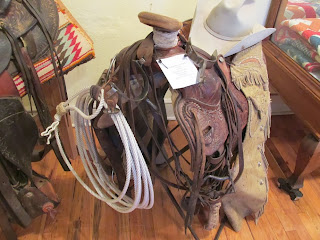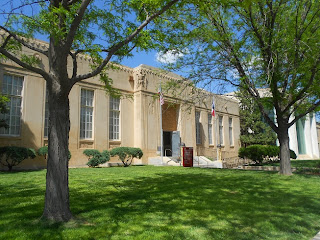 |
| Sculpture at American Quarter Horse Museum |
Hubbard Museum of the American West
Located in beautiful Ruidoso New Mexico, the Hubbard Museum of the American West is an affiliate of the Smithsonian and lets the visitor experience the west through the influence of the native Americans, the Hispanic people and the old pioneers. The museum is perfect for young and old and takes you through the different stages of the old west. Plenty of antique artifacts and clothing are part of the exhibits. You'll also find many exhibits about the horse and it's role in the development of the American west.
The American Quarter Horse Hall of Fame and Museum
The American Quarter Horse Hall of Fame and Museum is located in Amarillo Texas directly off Interstate 40. When you're looking for things to do in Amarillo, it's a great stop. A perfect addition to your western road trip or vacation. It's also at the headquarters of the American Quarter Horse Association.
 |
| Ruidoso New Mexico |
The XIT Ranch was at one time one of the largest ranches in the world spanning over 3 million acres. The ranch ran from the northwest corner of Texas southward along the New Mexico border for about 200 miles. The XIT Museum located in the Texas Panhandle town of Dalhart includes exhibits about the life and times on the old XIT Ranch as well as the development of the Texas Panhandle and the railroad that helped it grow. Dalhart Texas is northwest of Amarillo and about forty miles south of the Oklahoma state line and about forty miles east of the New Mexico state line.
The Pro Rodeo Hall of Fame and Museum of the American Cowboy
This fascinating museum is located in Colorado Springs, CO near the foothills of beautiful Pikes Peak. Several different halls are showcased here including the National Finals Rodeo Gallery, the heritage Hall and the Hall of Champions. The Hall of Champions honors cowboys in each rodeo event.
The Panhandle Plains Museum
Located in Canyon Texas about twenty miles south of Amarillo, the Panhandle Plains Museum opened during the Great Depression in 1933. The museum is on the campus of West Texas A & M University. This museum is sometimes referred to as the Smithsonian with a Texas accent" and is very well worth the trip to Canyon Texas to enjoy. The museum and the town of Canyon is just a few miles west of Palo Duro Canyon State Park which is one of the most scenic areas of Texas.
 |
| Exhibit of Spanish or California style spurs |
The Spaniards transported horses by ship from Spain. It's been said that the first time the Native people of Mexico saw a Spaniard riding on horseback that they were in awe. Many thought that what they saw from a distance was one beast, rider and horse being one animal. Much of the Spaniard's success in conquering the Mexican tribes was it's tactical advantage with the horse.
Wild Horses and Longhorn Cattle
The Spanish settler continued to move northward toward the Rio Grande. When he settled more to the north he brought his livestock with him. They had more livestock than they readily could use. Eventually the horses multiplied and bands of wild horses began migrating northward out of Mexico and into Texas. This was spurred even more when the Spanish abandoned horses in Mexico before their departure.
 |
| Western Cowboy Saddle and gear |
Wild horses roamed the Texas landscape even during the time of Spanish ranching as did cattle. Without a real market for their cattle the Spanish rancher raised and branded cattle for local use. Supplying meat for the ranch and it's workers didn't require extensive herds and at the same time there existed ranch owned cattle there were also wild cattle herds. Some of these wild animals, horses and cattle, bred with ranch owned animals. All of these herds, wild and ranched, traced their ancestry to when Spain imported these beasts to North America during the sixteenth century.
Below are links to additional Western trips articles alwith more fun and educational trip stops...
Cattle Drives and a Tour of the Fort Worth Stockyards
A Tour of the National Cowboy and Western Heritage Museum
A Trip to the Panhandle Plains Museum
Three excellent books on the subject of the cowboy and cattle ranching include...
The Cowboy by author Philip Ashton Rollins.... The Cattle Kings by author Lewis Atherton and In the Days of the Vaqueros: America's First True Cowboys by Russell Freedman.
 |
| Western Roping Saddle |
When you view exhibits of cowboy gear, ropes, spurs, saddles, chaps, hats among other items, all have some type of Spanish and/or Mexican influence.The American cowboy obtained all the technique of his craft and the tools used in that vocation from Mexican sources. This included the horse he rode and the cattle he herded.
The cowboy's rope was at one time the reata or the lariat. These words are still used. The Spanish vaqueros and the American cowboys both practiced trick and team roping. This type of roping is still seen on western ranches as well as at rodeos.
Chaps were used for a practical purpose. Covering the cowboys trousers, chaps, generally made from leather, would protect the cowboy's legs from cactus, rocks and other obstacles while herding and at the same time adding a degree of warmth during the winter. The original chaps came from the Spaniards in Mexico who called them "armas".
While spurs were not an invention of the Spaniards, spurs used by the American cowboy were styled very much the same as what the Spanish vaquero used in North America.
 |
| Panhandle Plains Museum, Canyon TX |
The riding saddle used by the old west cowboy went by several names. Some of these include range saddle, cowboy saddle, stock saddle and Mexican saddle. These saddle have been termed Moorish in theirs basic form and are very similar to what the Moors brought to Spain from Africa over one thousand years ago. These were all far different than the flat English Saddle and were not favored by the cowboy.
(Article copyright 2013 Western Trips)

